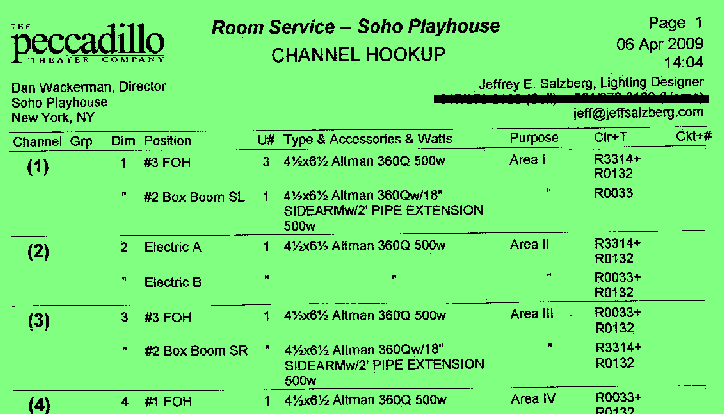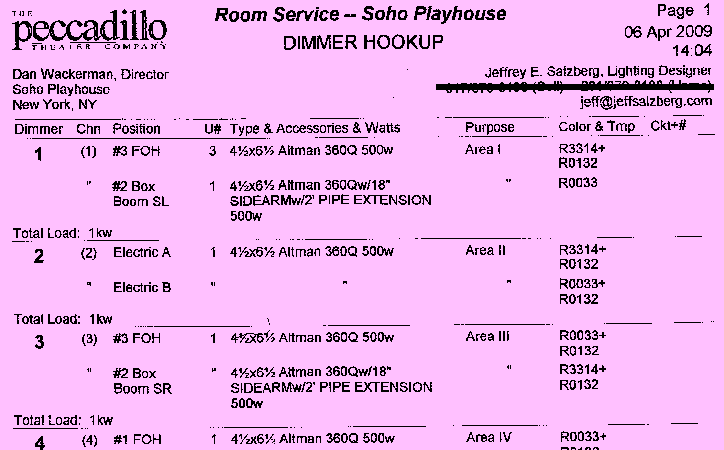|
Databases and Reports:
|
Most stage lighting paperwork consists of a database with all relevant information about the light plot
and the fixtures it contains, along with the various formats for reporting and organizing that information.
The purpose of this database is threefold:
- It serves as a guide during the initial hang and focus. In most cases, the paperwork has much
more information than could possibly be noted on the plot – the plot would be so cluttered that it would be difficult to read.
- It serves as a reference when trouble-shooting problems. For this reason, it must be kept
up-to-date as changes are made during the hang and focus and during rehearsals. This is usually
part of the Assistant Lighting Designer's or Master Electrician's job.
- It serves as a record should it be necessary to revive or otherwise recreate the production.
At a minimum, the paperwork database should always contain the following information for each fixture:
- Channel#
- Dimmer#
- Circuit# or Name
- Fixture# (or Unit #)
- Type of Fixture
- Wattage
- Purpose (such as "chair special" or "Area I")
- Accessories (if any)
- Template (if any)
- Color
It may, of course, contain other information as well, at the designer's discretion.
The paperwork is usually printed out in various report formats. These include:
- Channel Hookup: Data are arranged in order, by channels.
A typical (but not the only) situation in which this report is helpful is the channel check run by the
electrician and/or stage management before each performance.

- Instrument Schedule: The data are arranged in order of hanging position. Used
mostly during hang and focus, and for trouble-shooting afterwards.

- Dimmer Schedule: Arranged in order by dimmer. ("Hey Jeff! Dimmer 23's blown!
Into what dimmer can I move this circuit?" [My electricians are always grammatically correct. They
even follow rules of grammar which are not, technically, rules of grammar.])

- Circuit Schedule: Serves the same purpose for circuits that the Dimmer Schedule
serves for dimmers.
Some designers find it helpful to color-code their reports, as in the above graphics, so as to
make it easier to quickly locate the one that's needed. In addition to the ones listed above other formats
might include template schedules, accessory schedules, color schedules, etc.
The header of each report should include the following information:
- Name of the producer or producing organization
- Name of the production
- Venue name and location
- Title of report (Such as "Instrument Schedule" or "Channel Hookup")
- Page number (For example, "#1 of 2"). Alternately, this may be at the bottom of the page.
- The date the report was generated.
- Designer's name and title
It may also include:
- Director's name
- Assistant Lighting Designer and/or Master Electrician.
- Contact information such as telephone numbers and email addresses.
- An identifying graphic. This is particularly helpful to designers and electricians who may be
working on multiple productions simultaneously, as it helps to quickly identify the correct paperwork;
it may keep you from showing up for the hang of Death of a Salesman and discovering that
you've brought the paperwork for Swan Lake.
There are several methods of generating these reports. By far the most frequently-used in professional and
academic theatre is Lightwright®, a lighting specific database program written by John McKernon. It is
available for MacIntosh and Windows (and can be made to run over Linux) and is the closest thing we have
to an industry standard. The above examples were generated with Lightwright. There are other lighting
database packages available and, of
course, one can use a general purpose database such as Paradox or Access as well as spreadsheets and word
processors. The reports can also be written by hand:

| |
Magic Sheets:
|
A magic sheet (sometimes referred to as a "cheat sheet") is a quick reference, usually only one or two
pages long, giving the lighting designer quick visual access, sorted by purpose, to each channel and the
the fixture(s) it controls.

As you can see from the above example, the front light for the DL area was controlled by channel 1 and the
backlight for UC was in channel 18.
Since the magic sheet gets handled a great deal during the technical rehearsal period, it is a good idea
to print/draw it on card stock rather than on paper.
| |
Shop Orders:
|
If you're renting equipment, or purchasing large amounts of expendable
supplies, you or the Master Electrician will need to prepare a shop order. The rental shops or
theatrical suppliers will use this document to prepare competitive bids,
and the winning bidder will use it to prepare your order. If you're renting
or purchasing from more than one vendor, you will need a separate shop order for each.
John McKernon, the author of Lightwright, has, on his web site, an excellent
description of
"How to Write a Complete Shop Order".
|